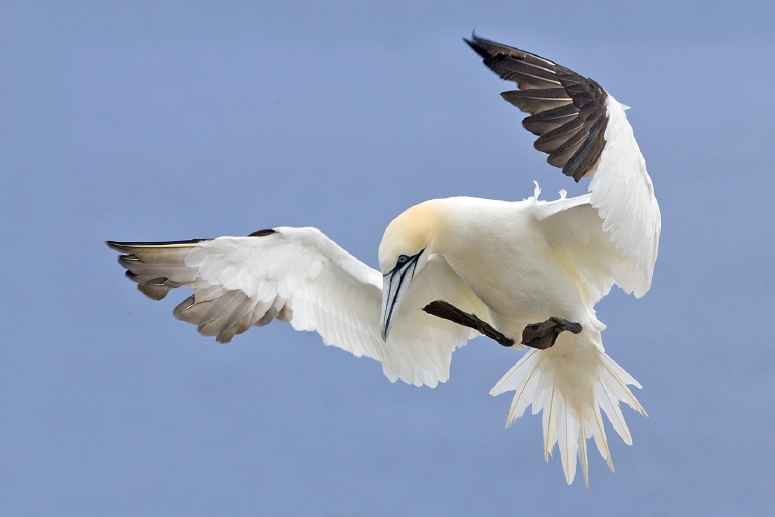|
| Query: Morus bassanus | Result: 2nd of 15 | |
Northern Gannet (Morus bassanus) - Wiki
| Subject: | Northern Gannet (Morus bassanus) - Wiki
| |

| Resolution: 775x517
File Size: 242306 Bytes
Upload Date: 2008:01:08 15:54:19
|
Northern Gannet
From Wikipedia, the free encyclopedia
Order: Pelecaniformes
Family: Sulidae
[Photo] Northern Gannet (Morus bassanus) at Bonaventure Island, Near Perce, Gaspe Peninsula, Quebec. Source: www.naturespicsonline.com/ Date: Early August 2006. Author: Alan D. Wilson.
The Northern Gannet (Morus bassanus, formerly Sula bassana) is a large seabird of the gannet family, Sulidae.
Young birds are dark brown in their first year, and gradually acquire more white in subsequent seasons until they reach maturity after five years.
Adults are 87-100 cm long and have a 165-180 cm wingspan. Their plumage is white with black wing tips. The bill is light bluish. The eye is light blue, and it is surrounded by bare, black skin. During breeding, the head and neck are brushed in a delicate yellow.
Their breeding range is the North Atlantic. They normally nest in large colonies, on cliffs overlooking the ocean or on small rocky islands. The largest colony of this bird, with over 60,000 birds, is found on Bonaventure Island, Quebec, but 68% of the world population breeds around the coasts of Great Britain, with the largest colonies on the Bass Rock (whence the species' Latin name) and Boreray, St Kilda.
Gannet pairs may remain together over several seasons. They perform elaborate greeting rituals at the nest, stretching their bills and necks skywards and gently tapping bills together.
They are migratory and most winter at sea, heading further south in the Atlantic.
These birds are spectacular divers, plunging into the ocean at high speed. They mainly eat small fish which gather in groups near the surface. Although they are powerful and agile fliers, they are clumsy in takeoffs and landings.
Although Northern Gannet populations are now stable, their numbers were once greatly reduced due to loss of habitat, removal of eggs and killing of adults.
Old names for the Northern Gannet include solan, solan goose and solant bird.
Isle of Lewis
In the United Kingdom, gannets are a protected species. However, a legal exception is made for the inhabitants of the town of Ness (also known as Port Nis) of the Isle of Lewis who are allowed to kill up to 2,000 gannets (locally known as guga) annually to serve as a traditional local delicacy - the taste is described as fishy.
Many of these gannets are taken from Sula Sgeir which is itself named after them.
http://en.wikipedia.org/wiki/Northern_Gannet
| The text in this page is based on the copyrighted Wikipedia article shown in above URL. It is used under the GNU Free Documentation License. You may redistribute it, verbatim or modified, providing that you comply with the terms of the GFDL. |
|
Comments |
|---|
| | Guest |
|
solan goose - very large white gannet with black wing tips
solan, solant goose, Sula bassana
gannet - large heavily built seabird with a long stout bill noted for its plunging dives for fish
genus Sula, Sula - type genus of the Sulidae |
^o^
Animal Pictures Archive for smart phones
^o^
|
|
|